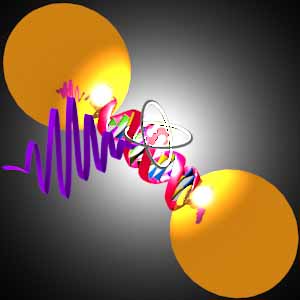Fuente: CNRS - All themes
Expuesto el: jueves, 26 de julio de 2012 22:00
Autor: CNRS - All themes
Asunto: Bio-inspired nanoantennas for light emission
| Since light is a wave, it should be possible to develop optical antennas capable of amplifying light signals in the same way as our televisions and mobile phones capture radio waves. However, since light oscillates a million times faster than radio waves, extremely small nanometer(2) (nm) sized objects are needed to capture such very rapid light waves. Consequently, the optical equivalent of an elementary antenna (of dipole type) is a quantum emitter(3) surrounded by two particles a thousand times smaller than a human hair. For the first time, researchers from the Langevin and Fresnel(1) Institutes have developed such a bio-inspired light nanoantenna, which is simple and easy to handle. They grafted gold particles (36 nm diameter) and a fluorescent organic colorant onto short synthetic DNA strands (10 to 15 nm long). The fluorescent molecule acts as a quantum source, supplying the antenna with photons, while the gold nanoparticles amplify the interaction between the emitter and the light. The scientists produced in parallel several billion copies of these pairs of particles (in solution) by controlling the position of the fluorescent molecule with nanometric precision, thanks to the DNA backbone. These characteristics go well beyond the possibilities offered by conventional lithography techniques currently used in the design of microprocessors. In the longer term, such miniaturization could allow the development of more efficient LEDs, faster detectors and more compact solar cells. These nanosources of light could also be used in quantum cryptography.
© Busson, Rolly, Stout, Bonod, Bidault Schematic representation of a nanoantenna formed of two gold nanoparticles linked by a DNA double strand and supplied by a single quantum emitter. Notes: (1) Researchers from the Institut Langevin (CNRS / ESPCI Paris Tech / UPMC / Université Paris Diderot) in Paris and the Institut Fresnel (CNRS / Aix-Marseille Université / Ecole Centrale de Marseille) in Marseilles. References: “Accelerated single photon emission from dye molecule driven nanoantennas assembled on DNA” Mickaël P. Busson, Brice Rolly, Brian Stout, Nicolas Bonod and Sébastien Bidault - Nature Communications, 17 July 2012
|

